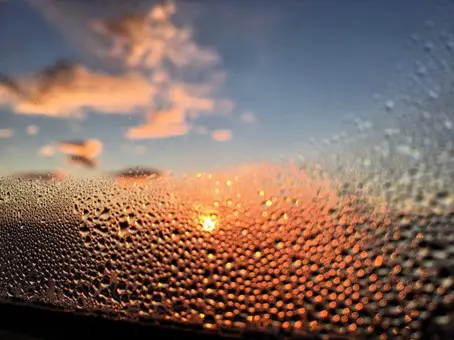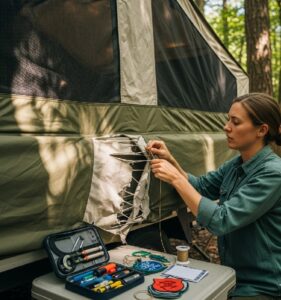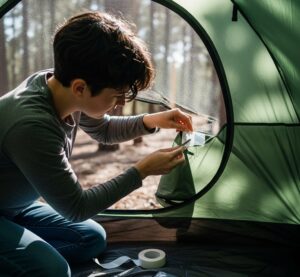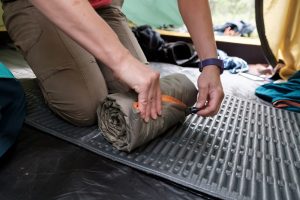Camping is a wonderful way for me to reconnect with nature, but if I’ve ever spent a night in a tent, I know that condensation can be a real issue. Waking up to a damp interior and dripping tent walls is far from ideal. Fortunately, there are several strategies I can employ to minimize or even eliminate condensation during my camping trips. In this guide, I’ll walk you through how I prevent condensation in my tent.
Before I dive into the prevention methods, it’s essential for me to understand why condensation occurs in tents. Condensation happens when warm, moist air inside my tent meets cooler surfaces, like the tent walls or rainfly. This interaction causes the moisture in the air to turn into water droplets. To combat condensation effectively, I’ll need to address the factors that contribute to its formation.
Tips for Preventing Condensation in Your Tent
Condensation inside a tent can be a common issue, especially in certain weather conditions. Here are some tips to that have helped me minimize and prevent condensation during my camping trips:
1. Choose a Suitable Tent
I start by selecting a tent that suits the weather conditions I’ll encounter. Double-wall tents with separate rainflies are generally better at managing condensation. These tents provide better airflow and insulation, helping to reduce the buildup of moisture inside. However, there is no perfect tent which will totally prevent condensation on its own – but a good quality tent is a good first step.
2. Choose My Campsite Wisely
The location of my campsite plays a crucial role in condensation control. I opt for well-ventilated areas with good airflow. I avoid setting up my tent near bodies of water, as these areas tend to have higher humidity levels, increasing the likelihood of condensation. Choosing an open and elevated spot can contribute to better air circulation.
3. Maximize Ventilation
Proper ventilation is key to preventing condensation. I make use of all available vents and openings in my tent. I leave doors partially unzipped, especially when the weather is fair, to allow fresh air to circulate. This helps to balance the internal and external humidity levels, reducing the chances of moisture buildup.
4. Rainfly Management
I use the rainfly appropriately to protect my tent from the elements. I ensure that it is taut but not touching the tent walls. This setup prevents moisture from getting trapped between the rainfly and the tent body. A well-managed rainfly allows for proper ventilation while still providing protection against rain and dew.
5. Reduce Interior Moisture
I minimize the introduction of moisture into my tent by storing wet gear outside or in a vestibule. Wet gear can contribute significantly to condensation. Additionally, I limit activities inside the tent that release moisture, such as cooking or drying wet clothes. I consider doing these activities outside the tent to maintain a drier interior.
6. Correct Pitching
When setting up my tent, I ensure it is pitched at the right angle. Proper pitching promotes better airflow both inside and outside the tent. A well-pitched tent allows for more efficient moisture evaporation and reduces the likelihood of condensation. I take the time to properly tension the tent fabric to maximize its performance in various weather conditions.
By implementing these tips, I can enhance the comfort of my camping experience and reduce the impact of condensation in my tent, ensuring a drier and more enjoyable stay in the great outdoors.
Condensation Solutions & Products
These days there are several products available that can help prevent or remove condensation from your tent.
Moisture-Absorbing Packs
When it comes to maintaining a dry and comfortable environment inside my tent, incorporating moisture-absorbing packs is a wise choice. Desiccant packs or moisture-absorbing crystals serve as effective tools in regulating humidity levels within the tent. By actively absorbing excess moisture, these packs can significantly mitigate the risk of condensation, creating a more pleasant camping experience.
Portable Fan
A small, battery-powered fan can help circulate air inside the tent, which reduces the opportunity for moisture to settle on the walls.
Camping Towels
Microfiber towels are super absorbent. Hang them strategically in your tent to catch moisture droplets and reduce the overall humidity.
Insulation and Footprints
Insulating the tent floor or utilizing a footprint is a strategic approach to prevent condensation. This additional layer acts as a barrier, preventing dampness from penetrating the tent and safeguarding the interior against ground-level moisture. This precaution is particularly beneficial for campers seeking an extra layer of protection in challenging weather scenarios.
Sleeping Gear
Investing in high-quality sleeping gear is paramount for a comfortable and dry camping experience. A top-notch sleeping bag and pad play pivotal roles in maintaining warmth and minimizing contact with the cold tent floor. By choosing a well-insulated sleeping bag and a reliable sleeping pad, I not only ensure a cozy night’s sleep but also reduce the likelihood of condensation forming beneath my sleeping area. Elevating myself off the ground adds an extra layer of insulation, preventing the transfer of cold and moisture to my sleeping setup. Ultimately, prioritizing quality sleeping gear contributes significantly to a dry and comfortable camping environment.
Final Thoughts – Prevent Condensation When Camping
Condensation in tents can be a nuisance, but with the right strategies, I can significantly reduce its impact on my camping experience. I remember to select a suitable tent, choose my campsite carefully, and optimize ventilation. I keep interior humidity low, set up my tent correctly, and consider using additional solutions like moisture-absorbing products, insulation, and proper sleeping gear.
By following these tips, you’ll be well-prepared to enjoy your camping trips without waking up to a damp and uncomfortable tent. Embrace the great outdoors without the damp and condensation, and happy camping!
FAQs
Why does condensation form inside my tent?
Condensation happens when warm, moist air inside your tent meets cooler surfaces like tent walls or the rainfly, causing water droplets to form. This is a common issue, especially in humid or cold conditions.
How can I prevent condensation in my tent?
You can reduce condensation by choosing a well-ventilated tent with a separate rainfly, pitching your tent in open areas with airflow, and maximizing ventilation through vents and partially unzipped doors. Proper setup and campsite selection are key factors.
What type of tent is best for reducing condensation?
Double-wall tents with separate rainflies are generally better at managing condensation because they allow better airflow and insulation. However, no tent completely prevents condensation, but a high-quality tent can significantly reduce it.
Does campsite location affect condensation?
Yes, campsite location is crucial. Avoid pitching near bodies of water, as they increase humidity. Choose open, elevated spots with good airflow to help minimize condensation inside your tent.
How does ventilation help with condensation?
Good ventilation balances internal and external humidity levels, which reduces moisture buildup. Using all available vents and leaving doors slightly open when possible helps air circulate and minimizes condensation.
How should I use the rainfly to reduce condensation?
Ensure the rainfly is taut but not touching the tent walls, which promotes airflow while still providing protection. This setup helps avoid trapping moisture between the rainfly and tent body.
Should I keep wet gear inside my tent?
It’s best to store wet gear outside or in a vestibule to reduce interior moisture. Wet items add to the humidity inside your tent, increasing the chance of condensation.
Can pitching my tent correctly help with condensation?
Yes, correct pitching allows better airflow and moisture evaporation. Ensure your tent is pitched at the right angle and tension the fabric properly to optimize airflow and reduce condensation risk.
Are there products that help manage condensation?
Several products can help, including moisture-absorbing packs, portable fans, and microfiber towels. These items absorb moisture or promote airflow, making the tent interior drier.
How does insulation reduce condensation in a tent?
Adding insulation, such as a tent footprint, helps prevent ground moisture from entering the tent. This barrier is especially helpful in cold or damp conditions.
What sleeping gear can help reduce condensation?
High-quality sleeping bags and pads with good insulation reduce contact with the cold tent floor, minimizing condensation beneath your sleeping area. Elevating your sleeping setup also helps prevent moisture transfer.
How can I enjoy camping without worrying about condensation?
Choose a suitable tent, carefully select your campsite, and use moisture-absorbing products. Optimize ventilation, store wet gear outside, and invest in quality sleeping gear. These strategies will keep your tent dry and enhance your camping experience.




